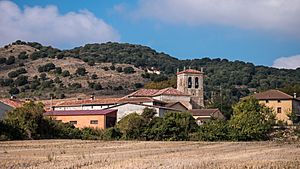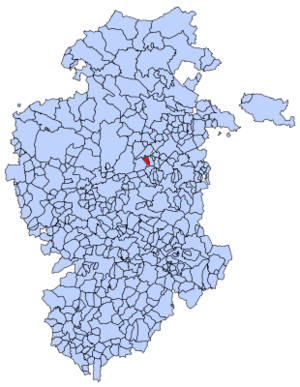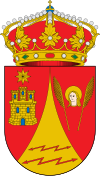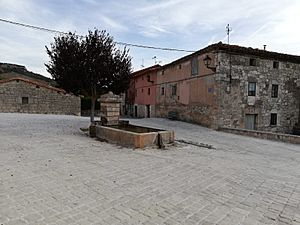Santa Olalla de Bureba facts for kids
Quick facts for kids
Santa Olalla de Bureba
|
||
|---|---|---|
|
Municipality and town
|
||
 |
||
|
||

Municipal location of Santa Olalla de Bureba in Burgos province
|
||
| Country | Spain | |
| Autonomous community | ||
| Province | ||
| Comarca | La Bureba | |
| Area | ||
| • Total | 10 km2 (4 sq mi) | |
| Population
(2018)
|
||
| • Total | 35 | |
| • Density | 3.5/km2 (9/sq mi) | |
| Time zone | UTC+1 (CET) | |
| • Summer (DST) | UTC+2 (CEST) | |
| Postal code |
09292
|
|
| Website | http://www.santaolalladebureba.es/ | |
Santa Olalla de Bureba is a small town and municipality in Spain. It is located in the province of Burgos, which is part of the Castile and León region. In 2004, about 33 people lived there.
Contents
Where is Santa Olalla de Bureba located?
Santa Olalla de Bureba is found in an area called La Bureba. It sits near the Cerratón River, close to the towns of Monasterio and Quintanavides. Major roads and a railway line also pass nearby.
What does the name Santa Olalla mean?
The name Santa Olalla means "Saint Eulalia." There are other towns in Spain with a similar name, for example, in the provinces of León and Palencia.
A brief history of Santa Olalla de Bureba
Santa Olalla de Bureba is located at the foot of a mountain range called La Brújula. The Ebro River flows through part of its land. The town's name comes from Saint Eulalia, a young woman who was honored for her bravery in the early 4th century.
How the town got its name
When people settled here, probably in the 9th century, they brought a special item (a relic) of Saint Eulalia. This is how the new town got its name. The Latin name for Eulalia is Olalla. The word "Bureba" was added to its name to tell it apart from other towns with the same name.
Early records and growth
The first time Santa Olalla de Bureba was mentioned in writing was in the year 1011. This was in a document about the founding of the Monastery of San Salvador de Oña. A count named Don Sancho I gave half of his property in Santa Olalla de Bureba to this monastery.
About a hundred years later, there was another town called Villasuso in the same area. Over time, Santa Olalla de Bureba grew and included Villasuso and its people.
Special rights and privileges
In 1146, King Alfonso VII gave a special set of laws, called a charter, to the town of Cerezo de Río Tirón. These laws also applied to many other towns, including Santa Olalla de Bureba. These laws gave the towns benefits like fairer justice, fewer taxes, and special rights for grazing animals and collecting tolls.
Population and economy over time
During the Middle Ages and later, Santa Olalla de Bureba did not have many people. In the 13th century, it had fewer than a hundred residents. By 1591, the population had doubled. In 1843, there were 144 inhabitants. The people living there mainly grew flax (a plant used to make linen) and worked in a jasper quarry.
In the 18th century, the town also benefited from being on the Camino Real, an important road from Madrid to France.
Modern developments and changes
The 19th century brought the railroad to Santa Olalla de Bureba. By the middle of the century, a train line from Madrid to Paris was already running through the area.
In the 20th century, Santa Olalla de Bureba became a key point for many services. A gas pipeline, an oil pipeline, a national highway, and the famous Camino de Santiago (Way of St. James) all pass through the town. While these connections helped the town economically, the population has decreased due to changes in industries.
See also
 In Spanish: Santa Olalla de Bureba para niños
In Spanish: Santa Olalla de Bureba para niños



